Inlays and Onlays: The Perfect Solution for Teeth Grinding Damage
If you’ve ever woken up with a sore jaw or noticed your teeth looking a bit worn down, you might be dealing with bruxism, commonly known as teeth grinding. This often-overlooked issue can cause significant damage to your teeth over time. But don’t worry – there’s a solution that can help repair the damage and protect your smile: inlays and onlays. Let’s explore how these dental treatments can be the perfect fix for teeth affected by grinding.
Understanding Bruxism and Its Effects
Before we dive into the solution, it’s important to understand the problem. Teeth grinding causes can vary, but stress, sleep disorders, and misaligned teeth are common culprits. Many people experience nocturnal bruxism, grinding their teeth while they sleep without even realising it.
The Impact on Your Teeth
Constant grinding can lead to several issues:
Worn Enamel
The protective outer layer of your teeth can become thin, leading to sensitivity and increased risk of decay.
Cracked or Chipped Teeth
The pressure from grinding can cause small fractures or chips in your teeth.
Flattened or Shortened Teeth
Over time, your teeth may appear shorter or have a flat, worn-down appearance.
Jaw Pain
The jaw clenching effects can lead to temporomandibular joint (TMJ) disorders, causing pain and difficulty in jaw movement.
Enter Inlays and Onlays: Your Dental Saviours
When it comes to repairing teeth damaged by grinding, inlays and onlays offer a perfect middle ground between fillings and full crowns.

What Are Inlays and Onlays?
Think of inlays and onlays as custom-made puzzle pieces for your teeth:
Inlays
These fit inside the cusp tips (top edges) of your tooth, repairing damage within these boundaries.
Onlays
These extend over one or more cusps of your tooth, providing more extensive coverage for larger areas of damage.
Why They’re Ideal for Grinding Damage
Inlays and onlays offer several benefits for teeth affected by bruxism:
Strength and Durability
Made from strong materials like porcelain or composite resin, they can withstand the forces of grinding better than traditional fillings.
Preservation of Tooth Structure
Unlike crowns, which require significant tooth reduction, inlays and onlays preserve more of your natural tooth.
Custom Fit
Each inlay or onlay is crafted to fit your tooth precisely, ensuring a perfect bite and reducing the risk of further damage.
Aesthetically Pleasing
They can be colour-matched to your existing teeth, restoring not just function but also appearance.
The Treatment Process
Getting inlays or onlays typically involves a few steps:
Consultation and Assessment
Your dentist will examine your teeth and discuss the best treatment option for your specific case.
Preparation
The damaged area of your tooth is cleaned and prepared for the inlay or onlay.
Impressions
Moulds of your teeth are taken to ensure a perfect fit.
Fabrication
Your custom inlay or onlay is created in a dental laboratory.
Placement
Once ready, the inlay or onlay is bonded to your tooth, restoring its shape and function.
Prevention: The Key to Long-Term Dental Health
While inlays and onlays can repair existing damage, preventing further grinding is crucial. Here are some strategies to consider:
Night Guards
Custom-fitted night guards can protect your teeth while you sleep, acting as a barrier between your upper and lower teeth.
Stress Management
Reducing teeth grinding stress through relaxation techniques, meditation, or counselling can help minimise bruxism.
Lifestyle Changes
Cutting back on caffeine and alcohol, especially before bed, may help reduce nighttime grinding.
Regular Dental Check-ups
Your dentist can monitor your teeth for signs of grinding and catch any issues early.
Taking the Next Step
If you suspect you’re grinding your teeth or have noticed wear and tear, don’t wait to seek help. Inlays and onlays could be the perfect solution to restore your smile and protect your teeth from further damage. Remember, every smile is unique, so it’s important to consult with a dental professional to determine the best treatment plan for you.
By addressing teeth grinding damage with inlays and onlays and implementing preventive measures, you can safeguard your dental health and maintain a beautiful, functional smile for years to come. Your future self (and your teeth) will thank you!
